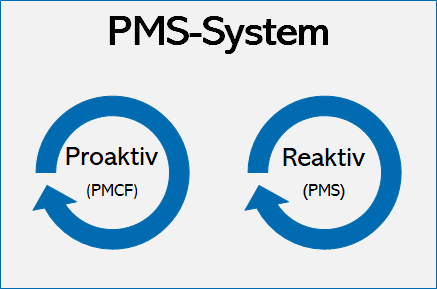- PMCF for medical devices
- 10. August 2020
PMCF - Post-market clinical follow-up under the MDR
The MDR brings with it a number of new terms and abbreviations. One of them is PMCF - Post-market clinical follow-up. But what exactly is that? In this article we will explain what this is about. You will also find out for which products PMCF is required and what possibilities there are to implement this requirement of the MDR. Additionally, you can download the templates for the PMCF Plan and Evaluation Report, which are attached to the MDCG documents.
The Medical Devices Regulation brings with it a number of new requirements in the area of post-market surveillance. It is not that a good PMS system would not have been able to cover many of the MDR requirements at the time of the MDD. But now expectations are becoming clearer and implementation more consistent. The MDR now makes PMCF an essential part of post-market surveillance. This is part of a holistic life cycle model. During the life cycle of a medical device, clinical data should be generated and evaluated on a permanent basis and used, for example, to update the clinical evaluation.
A PMS system according to MDR contains two subordinate systems. One of them is reactive, the classical PMS; the second is proactive. The proactive part is made much more important by the Medical Devices Regulation than it was under the MDD.

The call for the proactive approach to clinical follow-up and the increased focus on post-market surveillance has practical reasons. Although comprehensive risk management and meaningful clinical trials can be carried out during the development of a medical device, risks often only become known during the application of the products in the field due to scaling effects.
For which products is PMCF needed?
PMCF is generally required for all products. However, it is possible to justify non-application during the clinical evaluation. This justification depends on the type of device, the intended purpose and the risk class and must explain in a meaningful way why PMCF is not necessary. The more risky a device is, the more difficult it is not to carry out clinical follow-up. A PMCF plan is required in all cases, even if the measures themselves have been justified as unnecessary. The plan then refers to the appropriate place in the clinical evaluation report.
PMCF and Class III and implantable devices
For devices in Class III and implantable devices, Article 61 on clinical evaluation describes in paragraph 4 possibilities for making clinical follow-up mandatory.
Where a clinical investigation has been waived for one of the following reasons, an appropriate post-market clinical follow-up plan must be drawn up. This plan must describe the conduct of PMCF studies to demonstrate the safety and performance of the device.
- Your device was designed by modifying a device you have already placed on the market
- You have demonstrated that the modified product is similar (equivalent) to the product already on the market and your Notified Body accepts the demonstration
- The clinical evaluation of the device already placed on the market is capable of demonstrating the applicable General Safety and Performance Requirements for the modified device
PMCF link and clinical evaluation
Already under the MDD, clinical evaluation was linked to post-market surveillance. Since the Medical Device Regulation places a stronger focus on the proactive part, i.e. clinical follow-up, this is naturally reflected in the link to clinical evaluation.
Generation of clinical data
Clinical follow-up as a tool to proactively generate data on safety and performance is an important part of the holistic concept of MDR. Data should be generated throughout the expected lifetime of the device in order to be used, for example, to update the clinical evaluation and to continuously accept the benefit-risk ratio.
Clinical data is information on the safety or performance of a device, generated during use and derived from the following sources:
- Clinical investigations
- Clinical trials or scientific literature on an equivalent product
- Other published clinical experience that has been peer reviewed
- Information from post-market monitoring and clinical follow-up
Update of the clinical evaluation
The clinical evaluation is the interface where all available information comes together to demonstrate the safety and performance of the device. In addition to preclinical data, clinical data of course play a decisive role.
The use of medical devices in the field often leads to problems that could not be identified before. These data are important aspects of patient safety, as the risk-benefit ratio is also reassessed via the regularly updated clinical evaluation. For this reason, the data from the clinical follow-up are so crucial for updating.
PMCF study and other measures
There are different ways to generate appropriate data via the proactive path of clinical follow-up. Some of them are presented in the following section.
PMCF Study
Conducting studies with an appropriately sound study design is the gold standard for generating clinical data. Such studies are covered by ISO 14155 and must be conducted according to this standard.
Attention should be paid to the choice of study endpoints and statistical basis in order to generate adequate data quality.
Application observation / survey
The survey of users, e.g. doctors, can provide helpful information about a product. Care must be taken that the application observation is clearly distinguished from a study and that no patient data are evaluated that would require a declaration of consent.
PMCF Templates
The Medical Device Coordination Group (MDCG) has provided helpful documents for the uniform documentation of clinical follow-up. In addition to useful explanations, there are also two templates that should be used.
The PMCF Plan Template can be downloaded here.
The PMCF Evaluation Report Template can be downloaded here.